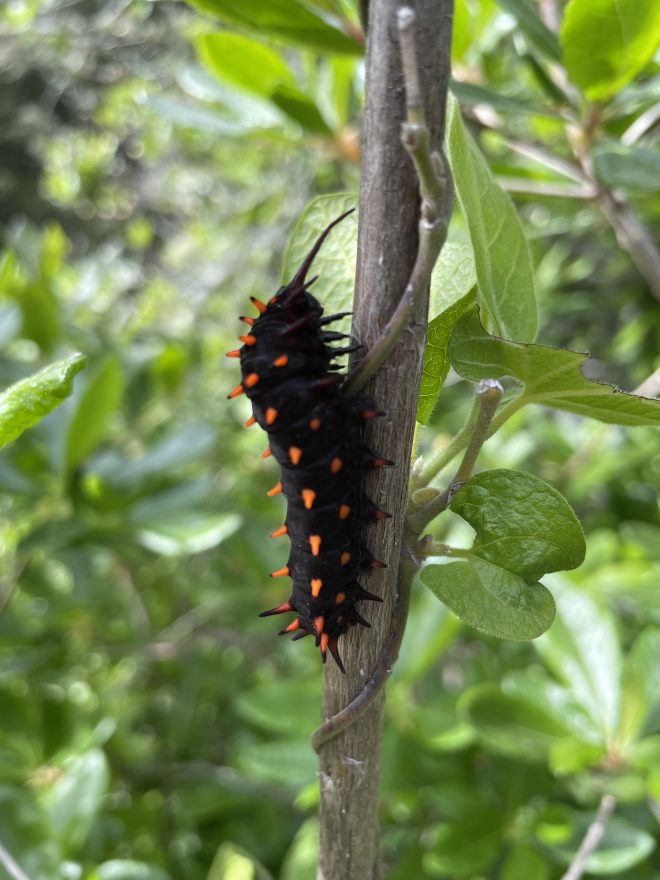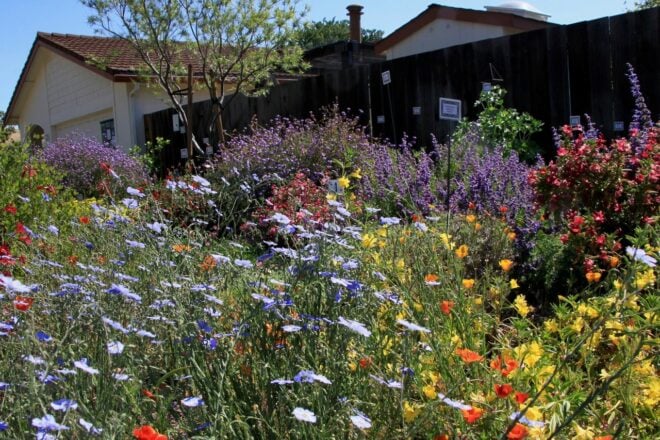
Voices of the West; New Science on Life in the Garden: Native Plants

Contributor
- Topics: Growing for Biodiversity, Headline
Spring 2024
As a gardener, I want it all—a thriving habitat full of native plants designed to attract wildlife, plants that evoke childhood memories, fragrant blossoms, intriguing foliage, delicious treats, and beautiful, inviting spaces for hanging out. Surprisingly, delving into the recent science on native plants for insects and other wildlife has inspired me to add more non-native lavender (Lavandula spp. and cvs.) to my garden. Recent research suggests that lavender may serve as a helpful trap plant (a plant that draws wildlife attention from another plant) that attracts the non-native honey bees with which it evolved and leaves more native plant resources to the native bees.
Of course, the ongoing search for the perfect plants for my garden regularly leads me to the universal native plant conundrum—what is a native plant and are they always a better choice than non-natives? Establishing the difference between native and non-native plants used to be straightforward for the average gardener. A native plant evolved in our area, while a non-native plant came from somewhere else. Of course, it isn’t as simple as that, and when it comes to horticultural practices, it can become downright nebulous.
Header Photo: Most of the bees on lavender are non-native honey bees or common bumble bees. Credit: Jennifer Alexander, © Oregon State University
How to find the best native plants for your garden
By popular convention, we often use biologically arbitrary boundaries for native plants. For example, gardeners in California see plants labeled as “California native” and may assume these are well-suited for their landscape. However, consider the breadth of botanical and biome or ecosystem diversity in that state, which further spills over the borders. Using geographic areas defined by flora species, like the California Floristic Province (CFP), to help define native plants is an improved alternative approach but still not the silver bullet.
The CFP includes parts of Baja, Nevada, and Oregon, and excludes parts of eastern California (included in the Big Basin Floristic Province). Defined areas like these are still much too broad to be of much use in our landscape plant choices. Within their boundaries are sub-regions that include deserts, redwood forests, chaparral, seashore, and many other botanically distinct ecosystems.

To further confuse things, oftentimes non-native plants are so well established historically that visitors and residents alike think of them as practically native. Eucalyptus (Eucalyptus spp. and cvs.) says “California” to many people, and we expect to see exuberantly flowering tropical trees and shrubs in Hawaii, yet these plants aren’t native to those regions, and they won’t “become” native no matter how long we grow them. The flora that evolved in any region has been doing so for about 479 million years.
Rather than working from broad native classification to assemble your native plant palette, it is best for gardeners to drill down to identify true natives of their sub-region and understand the limitations of their growing environment and which plants will be best adapted to their unique locale. Within your range of choices, it’s also important to select for diversity.
Diverse natives are vital for creating healthy garden food webs

While it is widely known that native plants are important for their vigor and sustainability, there is ample research that indicates that they are preferable to plants from other regions for supporting a healthy food web. Early and continuing studies from the lab of Dr. Doug Landis, at Michigan State University, have inspired many others to conduct investigations into the questions we explore here. My own academic path in graduate school was informed by a Landis lab publication on attracting beneficial insects with native flowering plants, as it considered parasitoids and predators in addition to pollinators—an uncommon focus at the time.
In our approach to the built landscape, planting habitat for pollinators has become a common refrain. We plant flowers for butterflies, hummingbirds, and bees of all kinds. Dr. Scott Black, executive director of the Xerces Society for Insect Conservation, has been turning over rocks and mucking about in streams since childhood. His focus at Xerces is how we can use science to communicate the importance of invertebrate conservation. He tells us we should broaden our ideas and points out that the Xerces Society offers well-documented downloads of plant lists for different regions. “We need to be thinking beyond flowers. We are more and more, and have been for years, incorporating host plants for butterflies and moths. A lot of the plant lists out there, they’re all for bees.”
There is a growing movement to include host plants for the caterpillars of the butterflies and moths we want to lure to the garden as adults, well beyond the familiar milkweed for monarchs. More gardeners are also considering how to support healthier garden food webs and attract lady beetles, lacewings, hover flies, and other beneficial insects that prey or parasitize other insects, in addition to providing resources for herbivorous insects.
“Plants and insects are the fabric of the planet, and we’re ripping that fabric apart. We can’t have good insect or invertebrate populations without good plant populations, but we can’t have good plant populations without good insect and invertebrate populations. They’re intertwined,” says Black.

Garden food webs feed more than just insects
Plants are the organisms that convert the sun’s energy into food for every other living organism on the planet, either directly or indirectly. Herbivorous insects, as they munch their food plants, are principal players in converting plants into food for other organisms, often by providing their own protein rich bodies as food. Most herbivorous insects specialize on native plant species and have coevolved with a community of other species, and a complex web of interactions. We can’t support healthy food webs without considering the herbivorous insects, and the predators that feed on them.

Most of the herbivores in our gardens are insects, but there are also some larger plant munchers, and native plant gardens can be a benefit to them as well. At The Gottlieb Native Garden, a flourishing California native plant ecosystem located on the grounds of a private residence in Beverly Hills, naturalist Scott Logan oversees the 95-percent-native landscape and observes that deer are not an issue, just a part of the food web: “A mule deer can come in and just mow down your garden in five minutes if it’s roses and exotic flowers–deer love them. The amazing thing about native plants is that they’re just what they’re normally eating. They come in–they’re in the garden all the time–and they’ll nosh on this and that and they’ll leave. They don’t mow down anything. There’s nothing there that’s so fantastic to them.”
Understanding that the food source of common birds is mainly herbivorous insects, and that these and other forms of wildlife are often closely tied to native plants is also fundamental to sustainable landscape design. If we are selecting our plants for habitat value, it becomes ever more important to more fully understand the implications of our plant choices on the wildlife with which we share our gardens. We are thinking about plant resources for wildlife well beyond pollinators.
What is the difference between a cultivar and a nativar?
While most of us are familiar with the term cultivar, indicating a cultivated plant variety, in the last 10 years or so, we have been increasingly seeing the term nativar. This is a horticultural term for a cultivated variety of a locally sourced native plant, coined in 2007 by renowned horticulturist Dr. Alan Armitage. Cultivars (and thus nativars) may be produced through selection, crossbreeding, or a chance mutation. Cultivars can also be hybrids, a cross of two different species, or sometimes genetically distinct populations.
Breeders are seeking desirable traits such as bloom size and color, foliage color, plant stature (usually more compact), stem strength, and disease and pest resistance. The word nativar can cause some confusion, sounding so much like native, but it should not be considered the same when planning a habitat garden. Some nativars may have several traits changed from the original wild form, which can substantially change their attractiveness to wildlife. Scientists are curious to understand how the differences between these cultivated native and wild native plants ecologically integrate into our wild and built landscapes.
More from this Series
Voices of the West; New Science on Life in the Garden by Frederique Lavoipierre
Did you know that oaks can harbor over 800 species of insects? That includes only those feeding directly on oak, where they feed on every part: bark, leaves, roots, flowers, seeds, and even between the layers of leaves. We don’t usually notice these insects, but we frequently spot the birds that feed on them. In addition to birds, spiders, and other arthropods, lizards, mammals, fungi, and many other organisms rely on oak-feeding insects for their own survival. >> Read More
Voices of the West; New Science on Life in the Garden: Biodiversity by Frederique Lavoipierre
Exploring biodiversity in gardens seems simple at first glance. Many of us define it in relatively simple terms—how many species of plants? Birds? Insects? Our gardens are relatively small ecosystems, but if we consider the possible number of interactions in even a small urban garden, it is immediately evident that biodiversity is almost unimaginably complex. >> Read More
Scientists use the term native cultivar to discuss these plants, rather than nativar, but the new term is here to stay. Scientists have concerns that these native cultivars might be perceived to be equivalent to the wild form of the native plant. Yet many in the nursery trade and at garden centers have embraced the term to communicate to their customers that they are responding to a desire for habitat plants with floriferous, generally more compact selections of native plants.
Native cultivars offer us some splendid choices—think of the glorious color palette of California poppies (Eschscholzia californica cvs.). Buttonbush (Cephalanthus occidentalis cvs.) is available in several more restrained compact forms, easier to integrate into gardens than the untidy form of the wild native. Coneflowers (Echinacea spp. and cvs.), not native to our region, now come in a rainbow of flower color and form. The availability of so many novel native cultivars has brought up questions about the wisdom of planting these new versions of native plants. Are these flowers as attractive to pollinators? Are the plants a resource for herbivorous insects and birds? Will flower visiting parasitoids and predators use them as a resource? Do the native cultivars impact the local wild gene pool? Should we only plant wild type native plants in our gardens? Like so many of ecological questions, the answer is “it depends.”
More native cultivar research continues and is needed
Over the last 20 years or so, much relevant research on natives and native cultivars has been conducted in the eastern US. Dr. Douglas Tallamy at University of Delaware found that while most herbivorous insects will eat the foliage of green and variegated native cultivars as readily as the wild type, the anthocyanins included in red, purple, and bronze foliage acts as a feeding deterrent.


At the University of Vermont, Annie White, Ph.D compared natives to their corresponding native cultivars for attractiveness to pollinators, and found that while in 7 pairs, the wild type native species were preferred by pollinators over native cultivars, 4 pairs were equally visited, and in one case, the native cultivar was more visited than its wild counterpart. To further complicate her findings, while bees and butterflies had similar preferences, flies (important pollinators) showed no preference. At Mt. Cuba Center in Delaware, ongoing studies confirm that in general, pollinators prefer natives, but sometimes, cultivars are superior in providing floral resources.

In our region, relevant research is being conducted at Oregon State University (OSU) by horticulture professor Dr. Gail Langellotto—who led the Oregon Master Gardener Program from 2007–2023. Research has long been her passion; Landis was an early inspiration and Tallamy’s work has informed her studies. Langellotto and Tallamy, academic siblings so to speak, both earned their Ph.D with Dr. Robert Denno, a leader in insect ecology, over 20 years apart. Denno studied many foundational aspects of food web dynamics, sometimes in cultivated settings, that continue to inform current research. Langellotto carries this inspiration forward – she currently leads leads the OSU Garden Ecology Lab, where her team studies how to design and sustainable manage landscapes to maximize system services.
Pacific Horticulture recently featured the study Langellotto’s Ph.D student Aaron Anderson (now with the Xerces Society) conducted, assessing native Pacific Northwest plants for pollinators. “After Aaron’s amazing Ph.D work, I thought what does this mean that we have to test? Do we have to test every plant?”
Jen Hayes is a current Ph.D student in the Langellotto lab who is working on an approach to these thorny questions. Langellotto says “Jen’s project was designed in part to try to understand those features and traits of plants that are altered during cultivation and selection that may positively or negatively affect pollinators in particular. What she’s found is that by and large most pollinators are more
attracted to the wild type native than their cultivars—but not always. In the case of Douglas aster, there were more pollinators attracted to the cultivars than the wild type.”
Interestingly, the wild type Douglas aster (Symphyotrichum subspicatum) was more important than the cultivars for the bumble bee life cycle. Bumble bees require floral resources late in the blooming season, when new queens forage before overwintering; the native cultivars in this case have a shorter blooming season than the wild types, and are finished blooming before new queens emerge.


In the presentation “Native Plants for Pollinators: What do we know about cultivars?”, Jen Hayes discusses California poppies, camas (Camassia spp.), clarkia (Clarkia spp.), western columbine (Aquilegia formosa), and yarrow (Achillea spp.), among other plants. A fascinating example involves farewell-to-spring (Clarkia amoena) and its use as both a pollen and nesting resource for bees.
Langellotto says “We’re starting to understand that color changes have really large impacts on pollinators, and that even the ultraviolet signals (invisible to the human eye) may be altered during the process and can negatively affect pollinators. So far, color is the leading lady, and UV signals are secondary.” It will be fascinating to follow this research in the years to come; in the meantime, observant gardeners may come to their own conclusions.

Should you avoid growing non-native plants?
Gardeners usually include or allow existing non-natives in their plantings even when they favor natives. There can be an emotional or aesthetic attachment to the plants we want to include in the landscape. Many gardens contain non-native vegetables, herbs, and fruits. Very few people are purists when it comes to plant choices in gardens, as opposed to wild restoration projects in which all-native is the sensible choice. Regardless, all gardeners should be especially conscientious when choosing non-native fruiting and seeding plants to ensure they are not invasive; seeds may be deposited miles away by birds.
In Anderson’s research, one intriguing finding is that non-native lavender (Lavandula x media ‘Grosso’), oregano (Origanum vulgare), and catnip (Nepeta cataria) were highly attractive to honey bees—also native to the same regions of the world, but not attractive (with few exceptions) to our wild native bees. Langellotto says this suggests a hypothesis: “We have noticed that there’s been sorting of honey bees versus native bees on the different plants that we work with. Lavender, in particular, might be able to be used as a trap plant, if you will, for honey bees in a garden system. It might be a beneficial addition to a garden where you want to promote native bee persistence because it keeps the honey bees off of the plant which the native bees favor.” We can look forward to some interesting research emerging from the Langellotto lab in the coming years.
Growing natives vs native cultivars
In a wild plant population, genetic diversity can ensure survival in the face of adverse conditions, as the plants adapt to new circumstances. Wild plants with distinct regional populations may lose their unique genetics when we introduce native cultivars—one common example is the swaths of California poppies freely sown by so many gardeners. This apparent increase in genetic diversity isn’t the helpful kind—it is random, as opposed to an established population adapting over time to local conditions. This is why supporting your small, local watershed nursery is an advantage, ecologically speaking.

Native cultivars may have a very narrow genetic diversity, and if cutting propagated, may even be clones of a single plant, contributing no genetic diversity even when widely planted in a region. Native cultivars, however, can also offer some real advantages such as disease resistance, or the reduction of an undesirable garden trait such as suckering. Some native cultivars have sterile flowers, and while these are of no use to pollinators, they also can’t escape to cross with wild types.
On the other hand, it also stands to reason that we don’t notice that which we cannot observe. While a native cultivar or non-native plant may attract many species of bees, butterflies, and other insects, other wildlife species are almost certainly absent if their preferred wild native plants aren’t available.
For all the problems that native cultivars may present, they are often the only option when buying native plants, where they may not even be labeled as such. It may be difficult for large garden centers to offer wild type species due to lack of propagation material, sourcing plants from a large, centralized grower, inconsistency in the final product, and other factors. Ideally, but impractical to put into practice, native plants for sale would be primarily propagated from the local watershed. As gardeners, we can only continue to do our best to make educated choices.

How will climate change alter our native plant landscapes?
As climate change progresses, we may increasingly be translocating plants to new areas—a once controversial concept that is receiving increased attention. The Santa Barbara Botanic Garden (SBBG) is working on their Landscape Transformation Project with a climate-forward plant palette that includes natives from farther south and especially rare species in need of conservation. One question Dr. Denise Knapp, the director of conservation and research at SBBG, is interested in addressing in the future is if these plants are leapfrogged to another area, will the insects follow? This is a critical question as we translocate plant species going forward.
Langellotto says “In so many different ways climate change is affecting gardens, for instance through events such as the heat domes that we’ve had over the past couple of summers. Gardeners need to be prepared for extreme weather. Climate is influencing our choices to plants that may be more robust to these extreme weather events or to drier, warmer conditions.”
Furthermore, even formerly well-behaved non-natives may become invasive as the climate shifts—something to watch out for in your own neighborhood whenever you choose non-native plants.
What can you do to create an ecologically-friendly garden?
How can we sift through all the complexities and make suitable choices for our own landscapes? Black says “It’s pretty simple. Think about adding native plants. Think about wildlife, not just pollinators. Include host plants for butterflies and moths, and seeds for birds. Think beyond flowers, beyond plants to what these animals need the rest of the year–some bare soil for ground nesting bees or stick piles where butterflies can pupate. The cool thing that I always want to point out is gardeners can be such a part of the solution.”
When choosing non-natives, seek out non-invasive plant species. Choose flowers with pollen—many flowers labeled as “florist” may have been bred for reduced (or even no) pollen. Roses (Rosa spp. and cvs.) are beautiful, but choose those with fewer petals, allowing access to pollinators. If planting non-native grasses, seek out sterile forms such as ‘Karl Foerster’ reed grass (Calamagrositis x acutilora ‘Karl Foerster’).
When choosing native cultivars, choose those that have flowers close to the wild form, especially blossom color and number of petals. Plant size appears to have little, if any, impact on pollinator visitation.


One thing everyone agrees on is that even a few native plants in a garden can make a difference, and that locally grown wild types are almost always superior to cultivated natives, especially when it comes to supporting wildlife. Logan notes: “If people want to have birds in their yard, one of the biggest things to do is have opportunities for them to raise their chicks. Most food for their chicks is going to come from the insects and the insect larvae that are taking advantage of native plants.”

Plant a diversity of natives to attract a diversity of wildlife. Choose regional wild natives when you can. Small specialty nurseries are more likely to offer both regional wild type natives along with native cultivars. Some research beforehand, or onsite on your phone, can be helpful in choosing plants. Choose plants to bloom over a long season; early spring and late fall are especially important to some pollinators.
The research is clear that plants bred for anthocyanin-rich foliage are not useful to herbivorous insects. My own strategy is if I want to grow a purple-leaved elderberry (I do), I plant the wild native as well, preferably in more abundance than the native cultivar. We can be thoughtful in our plant choices and how we site them. We may welcome a mahogany-leaved ninebark (Physocarpus cvs.) in a prominent spot because it is less likely to be munched but still include the green-leaved wild native in another less visible part of the landscape.
At the Langellotto lab, research plans are in the work. “We have grants in the pipeline to look at different garden designs and what that might mean for beneficial insects and gardens. Aaron’s study looked at plants in isolation to identify those particular plants which are most attractive to different insects. But I’ve always wondered what happens when you put them all together in a holistic design,” Langelotto says.

More research is needed, but science is a slow and expensive process. The ungainly native buttonbush, for example, so useful in attracting beneficial insects in California Central Valley hedgerows, has three fairly new native cultivars that have not yet been evaluated for habitat value, ‘Sputnik’, Sugar Shack® (‘SMCOSS’), and ‘Fiber Optics® (‘BAILOPTICS’). There are many factors to study when assessing native cultivars: changes in the pollen alone brings up multiple possibilities, including the color and temperature tolerance of pollen, the size of the grains, the protein content, and more.
In the meantime, it is up to us to be observant, and add to our collective knowledge of how to create sustainable, thriving landscapes. “Gardeners are key and I believe we’ve got a little responsibility to do the right thing. Also consider sharing what you do with your neighbors or your friends or your family or others–together we can have a big impact,” says Black.
This article is sponsored by:
Resources
Dr. Gail Langellotto’s blog https://blogs.oregonstate.edu/gardenecologylab/
https://gardenecology.oregonstate.edu/sites/agscid7/files/gardenecology/reading_plant_labels.pdf
Jen Hayes’ presentation – Native Plants for Pollinators: What do we know about cultivars? https://youtu.be/NbRaE03NMkU?si=tTPjUtbsS97gKFf5
Annie White’s paper – From Nursery to Nature: Evaluating Native Herbaceous Flowering Plants Versus Native Cultivars for Pollinator Habitat Restoration https://scholarworks.uvm.edu/cgi/viewcontent.cgi?article=1625&context=graddis
National Wildlife Federation Native Plant Finder https://nativeplantfinder.nwf.org/
Calflora https://www.calflora.org/
Xerces Society https://xerces.org/
Santa Barbara Botanic Garden Landscape Transformation Project https://sbbotanicgarden.org/project/landscape-transformation-project/
The Native Gottlieb Garden https://thegottliebnativegarden.com/
Native Plants for Pollinators: What do we know about cultivars?












Responses